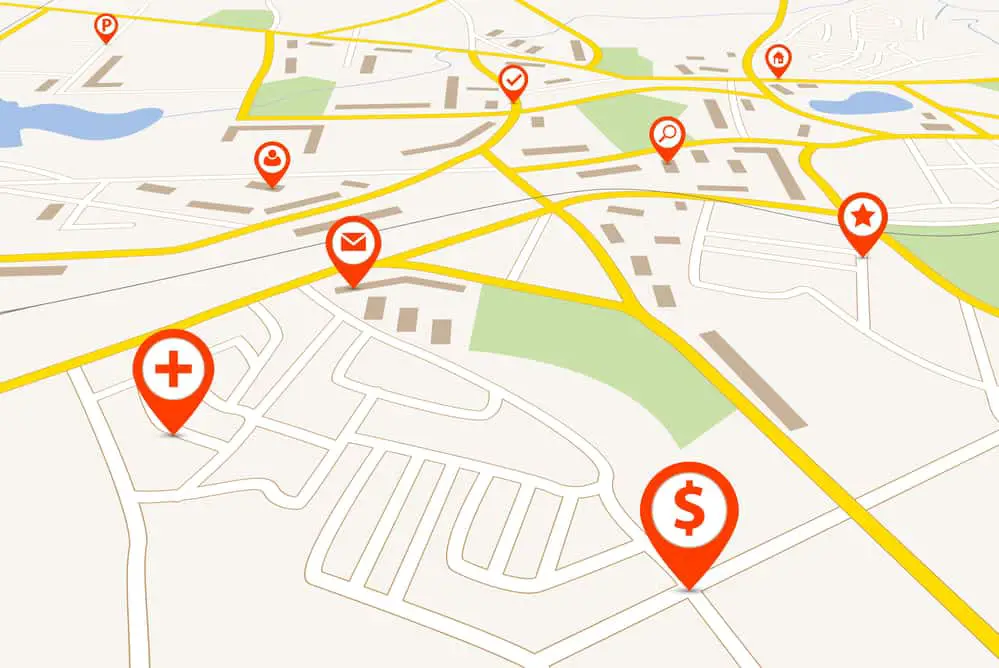Glossary of GPS Terms in 2025 (The Definitive List)

Learning about global positioning systems or GPS can lead you down a rabbit hole of technical material, many dealing with a seemingly foreign GPS terminology that makes it even more intimidating. This glossary of GPS terms will help you learn what it all means and keep you educated on the function and operation of GPS.
GPS Terms
Accuracy
This is a common measurement for how accurately the GPS can determine position. This is often referred to as being “accurate to within x meters”. High accuracy will be 3m or less, with less accuracy being near 10m.
Acquisition Time
This is how long it takes the GPS unit to acquire signals from satellites and begin calculating position. 3 locks for a 2D position, and 4 for a 3D position.
Active Leg
The leg of the route that is currently underway.
Almanac Data
This is a database of orbital information for all satellites and can help GPS receivers acquire satellite links much quicker.
Autonomous Positioning
The least precise method of GPS position calculation and is obtained from satellite data alone.
Azimuth
This is a horizontal direction that is measured as an angle in reference to another point, generally True North.
Base station
A GPS base station is a receiver set up with a known position, set up expressly for helping to correct the relativistic errors that are inherent in high orbit satellite timings.
Bearing (BRG)
The bearing will denote the direction of the route in the context of a compass direction from one waypoint to another. Once you have entered a waypoint, the GPS will give you the compass bearing you will need to follow to reach it.
Coarse Acquisition Code (C/A Code)
Also known as a clear acquisition code, the coarse acquisition code is what allows the GPS receiver to begin determining a rough position.
Carrier Phase
These are GPS measurements that have been based on either the L1 or L2 carrier signals
Cold Start
This refers to starting up a unit that has been powered off for a sufficiently long enough time that the cached ephemeris data is no longer valid. When powered up, the unit is starting with zero positional knowledge and may take several minutes to generate once running.
Control Segment
This is a global network of ground stations and satellites that work to preserve the accuracy of the GPS signals.
Coordinate Systems
A coordinate system is a map reference system that uses numeric or sometimes alphanumeric numbering schemes to describe locations.
Coordinates
Coordinates are the numbers, most often two, that are used with the rules of the coordinate system to determine a map location. They frequently consist of some reference to latitude and longitude.
Continuously Operating Reference Station (CORS)
Any permanent reference or base station that is in continuous operation.
Course
The course is the representation of the direction from the origin to the destination and can be measured in several different ways. The course can also be used to refer to the direction of travel between two waypoints.
Course Made Good (CMG)
The amount of the course that has already been traveled.
Course Over Ground (COG)
The distance of the course to be traveled in straight line courses.
Course To Steer
The steering correction needed to stay on course.
Crosstrack Error (XTE/XTK)
Errors that result from deviation in the planned course.
Data Dictionary
Sometimes referred to as a data logger or data recorder, this is a small computer that is used to store more data sets from the GPS receiver, which can be more complex than common handheld GPS units can display.
Data Message
This message is coded into the GPS signal, and it contains the satellite’s clock corrections, location, and condition. Sometimes it will also contain info on the rest of the constellation.
Datum
This is a geographic model that is created by combining sea level information with theoretical math. Your GPS unit’s datum should match your region and the datum on the local map legend.
Datum Transformation
Any common transformation that can be done to a datum.
Declination
The difference in true north and magnetic north bearing.
Declination Setting
The angular offset used when locating true north.
Desired Track (DTK)
This is the ideal compass bearing from the origin to the destination. It is not something that takes into account any of the waypoints for a route.
Differential Correction
A differential correction is a method for purging both natural and manmade errors from the GPS signal. It requires two GPS receivers, with one being set up at a known location, being used to negate the errors.
Differential GPS (DGPS)
Differential Global Positioning System is a process for correcting errors and adjust other factors of GPS signals. This system is assisted by permanent ground stations.
Dilution of Precision (DOP)
Dilution of precision is the geometric reduction inaccuracy. There are many types of dilution of precision, and they all have a significant effect on the accuracy of positioning. The scale runs from 1 to 7, with most GPS units ignoring signals of 6 or 7 by default.
Direction
Any of the cardinal compass directions that are used.
Distance To Waypoint
The remaining straight-line distance to the next waypoint.
Dual-frequency Receiver
A GPS receiver that can receive both L1 and L2 signals at once.
Earth-Centered Earth Fixed (ECEF)
This is a Cartesian coordinate system wherein the center or origin is the center of the earth. In GPS context, it is the center point of a datum considered the best fit for the size and shape of our planet. It is designated WGS84.
European Geostationary Navigation Overlay Service (EGNOS)
The European Geostationary Navigation Overlay Service augments American GPS and GLONASS systems with additional geostationary satellites.
Elevation
The measure of the position’s height about the mean sea level. It is represented as a direct vertical distance from the surface of the geoid.
Elevation Mask
The elevation mask is an angle below which satellites should be ignored. Frequently set between 7.5 and 15 degrees, depending on local obstructions.
Ellipsoid
A three-dimensional geometric shape is created by rotating any given ellipsoid about the minor axis.
Ephemeris
The ephemeris data comes from the current orbital position and path of a particular satellite. It is a constantly evolving dataset.
Epoch
In the context of GPS, an epoch is a moment in time, the moment in time when a particular measurement is made by the GPS receiver. The epoch rate is the interval at which the measurements are taken.
Error
Also called biases, errors that propagate in the GPS data. There are many types of errors, and they can be related to positioning, timing, ephemeris, and more. Many errors can be corrected or accounted for.
Estimated Position Error (EPE)
An estimated position error is a measurement of the error in the horizontal position, expressed either in feet or meters. The EPE is based on a number of things including signal quality and the DOP.
Estimated Time Enroute (ETE)
This is the estimated time remaining in your current navigation, assuming your current speed and course.
Estimated Time of Arrival (ETA)
Estimated time of arrival is often generated during initial navigation. It may also be updated continuously while moving, to reflect the most current eta based on present speed and course.
Fast-Multiplexing Receiver
This is merely a receiver capable of receiving fast-switching channels and signals from multiple sources.
Fast-Switching Channel
A fast-switching channel is a channel that quickly samples several satellite ranges. The switching is often as quick as 2-5 milliseconds between changing the range again, with the same time being long enough to capture the needed data.
Geometric Dilution of Position (DOP)
Geometric dilution of position is a type of degradation that can happen with GPS signals, and it is rated on a 1-7 scale with receivers often set to ignore scores of 6 or worse.
Geometric Quality
The geometric quality is the most probable accuracy of a position fix that is determined by considering the relative positions of the satellites.
Global Positioning System (GPS)
The global positioning system that was originally developed by the US Department of Defense. There are approximately 30 satellites in a variety of orbits that can help GPS receivers on the ground, in the air, and at sea determine their location on the globe.
GOTO
A built-in function that allows you the ability to designate any waypoint as your destination, and the GPS unit will guide you there.
Heading
Your heading will be the direction that you travel, without regard to the changing bearing from waypoint to waypoint. The heading will remain the same in relation to your origin and your destination, no matter the irregularity of the route.
Height Above Ellipsoid (HAE)
This is the height determined by GPS signals, above the WGS84 reference ellipsoid. Initially derived from the 3D Cartesian coordinates, it is converted to latitude and longitude coordinates with a corresponding height coordinate.
Horizon
The line where the earth and sky meet.
Horizontal Dilution of Precision (HDOP)
This is a dilution of precision that occurs concerning the horizontal position fix and can cause a geometric dilution of precision. As with all dilution of precision measurements, it is graded 1-7 and can be filtered out.
Interface Option (I/O)
The interface option directly affects the conveyance of gathered data from digital format to the real world, and vice versa.
Initialization
The very first time any GPS receiving unit starts up it will orient itself to its current position and store this information or future reference. If the receiver has not moved far, it will be able to use this information during each hot start to reduce the time to fix.
Invert Route
If a route was used to get to a particular location or waypoint, the reverse route will perform the navigation necessary to guide the user back the way they came.
L1
The L1 signal is the primary signal used by each satellite, and it is modulated to transmit the military P-code, NAV message, and civilian C/A code. It is one of two frequencies used.
L2
The second signal that is used by GPS satellites is L2, and it carries only the code needed to add or perform the precise positioning service.
Latitude
The position is measured as a distance either above or below, north or south, of the equator. It is measured in degrees.
Leg (Route)
A route leg is simply the straight-line path from one waypoint to any other adjacent waypoint. Complex routes can have hundreds of legs or more.
Location
Your location is given by the GPS as a set of latitude and longitude coordinates as well as an altitude coordinate most likely. It can be used for a variety of location-based services.
Longitude
This is the measurement of the position of a location, relative to the prime meridian. The prime meridian runs from the north pole to the south, using Greenwich, England as the meridian.
Magnetic Declination
Also known as magnetic variation, declination is used to indicate the difference in bearing between true north and magnetic north.
Magnetic North
The direction of the northern magnetic pole, to the observer’s location. The direction is a compass bearing.
Magnetic Variation
Magnetic variation represents the errors in the readings of magnetic compasses, due to natural fluctuations in the planet’s magnetic field.
Map Projection
This is the method of plotting the coordinates of the surface of the earth that fits our uses best.
Maximum PDOP
The maximum allowable PDOP before GPS stops computing to allow for error correction.
Mean Sea Level (MSL)
A value assigned to the sea level for purposes of altitude or height above sea level calculations.
Minimum Elevation
This is the minimum elevation at which the GPS will search for satellites, due to obstructions usually.
Multipath
This is signal interference of the primary GPS signal caused by reflection or signal bounce from nearby objects or structures. When the signal takes a longer or slower path, it results in inaccurate position measurements, which can be one of the most serious GPS errors.
Multipath Error
These are errors caused by signal interference, that has been received by the GPS unit from two or more different paths.
Multiplexing Channel
A channel that can be used to sequence several satellites, with a sampling rate coincident with the nav message bit rate.
NAVDATA
The NAVDATA is the 1500-bit message that is transmitted by every satellite at 50 bits per second, on both the L1 and L2 signals. The message contains information on the satellite’s time, clock correction, ionosphere delay info, ephemeris, currently.
Navigation
Navigation is the act of determining the current position and deciding on where to go. This can apply to land, sea, or air navigation.
Navigation Satellite Timing and Ranging (NAVSTAR) System
The formal name given to GPS satellites that were originally built by Rockwell International.
NOAA
The National Oceanic and Atmospheric Administration is the national weather authority.
P-Code
A protected code that is embedded in the signal for both L1 and L2. This code is no longer available to civilian users as it is now encrypted and available only for US military and allied military entities.
Parallel Channel Receiver
A receiver with multiple receivers each dedicated to a single satellite’s signal processing.
PDOP mask
A customizable top limit for the PDOP that is acceptable during GPS use and data collection. If PDOP increases beyond that limit, the data collection is halted to allow for correction.
Pixel
A word derived from the words “picture” and “element” and is the smallest picture element in any given display. Screen resolution is measured in a length by width measurement of the pixels in the display.
Position
A location on or near the earth that can be displayed using geographic information or coordinates.
Position Dilution of Precision (PDOP)
Position dilution of precision is a unitless measure of the relationship between errors in user position and errors in satellite position. They are measured on a scale of whole numbers, and anything under 6 is often considered acceptable quality.
Position Fix
The GPS unit’s calculated geographic location.
Position Format
This is the way in which the GPS receiver will display the position fix on the screen. This can be in degrees, degrees with minutes, or degree minute second format.
Postprocessing
This is gathering GPS data and using base and roving receivers that are not linked. All data is recorded independently and is corrected using special differential software.
Precision
This is related to the accuracy of the GPS computation, and can be accurate to within a few meters of the physical location, but also as inaccurate as signal quality and errors allow.
Pseudo-Random Code
This is an identifying code transmitted by every GPS satellite and then mirrored by the receiver to eliminate issues with background noise. It is a complicated repeating binary code.
Pseudorandom Noise or Number (PRN)
Pseudorandom noise is a binary code that appears to be random but can be recreated exactly.
Pseudorange
The pseudorange is the approximate distance from the satellite to the GPS antenna.
Radio Technical Commission for Maritime Services (RTCM)
This is a committee that defines a differential data link that is used by the GPS correction messages. These messages travel from a monitor to a field user.
Reference Station
A reference station is also known as a base station and is a permanent facility that is used to help correct signal errors from satellites. They are used in conjunction with roving stations to perform differential corrections.
Root Mean Square (RMS)
The root mean squared is a measure of the position that scatters around the correct position. RMS can be applied to all data.
Route
A route is the combination of several waypoints in the direction of desired travel. A route can be created manually by entering the waypoints in the order they must be reached. Your GPS will guide you to each waypoint along the way.
Rover/Roving Receiver
This is a GPS receiver that is not based in a permanent location and can measure the variance in GPS signals abroad. This is one-half of the stations needed for differential corrections.
Real-Time Kinematic (RTK)
Processing of kinematic data in real-time. This is only possible if the code and carrier data from the base station is transmitted in real-time to roving stations. A computer at the roving station will compute the differentials and give the results.
SA
Selective availability is a process that allows the government to limit the accuracy of the NAVSTAR positioning data. It can be done by either altering the orbit data or the satellite clock. This helps prevent the abuse of low-cost GPS receivers.
Satellite Constellation
A group of satellites that are aligned in purpose. The GPS satellites are comprised of 6 different orbital planes, with 4 satellites in each one.
Satellite-Based Augmentation System (SBAS)
These systems use geostationary earth orbit satellites to augment the GPS, GLONASS, and other satellite constellations. The signal is generated on the ground and sent to the satellite, which then rebroadcasts the signals.
Search The Sky
This is where the GPS first starts up and listens for satellites and ephemeris data.
Selective Availability (SA)
This is the government’s ability to limit the accuracy of the satellite data, for reasons of national security.
Signal-to-Noise Ratio (SNR)
A rating of the strength of the signal to the strength of the noise being received on the same channel or frequency.
Space Segment
A constellation of satellites that transmits data to other users.
Speed Over Ground (SOG)
This is the actual real-world speed of a GPS receiver that is traveling. This will often differ from airspeed or nautical measurements where the speed can be offset by environmental factors.
Straight Line Navigation
Going from one waypoint to another with no turns, simply traveling “as the crow flies”.
SV
This can stand for a satellite vehicle as well as a space vehicle.
Time Dilution of Precision (TDOP)
This is a dilution of precision that is due to the satellite clock or compensation being off and will produce geometric errors in the position.
TracBack
This is a feature common in GPS units that will record a log of movement, then convert that into a route with waypoints.
Track (TRK)
The track is the path of movement, irrespective of the heading or bearing. Track is not often used with land GPS but is common in sea or air navigation.
True North
The direction of the north magnetic pole relative to the current position.
Turn (TRN)
This is indicating a change in bearing at the next waypoint.
Universal Time Coordinated (UTC)
This is the local solar time relative to Greenwich, England, and is commonly used as a reference time zone.
Also read:
How to Get a Marine Radio Operator Permit?
Universal Transverse Mercator (UTM)
Part of the coordinate system that divides our planet into 60 different north-south zones.
User Interface
Used to enter or retrieve data from a system.
Velocity Made Good (VMG)
The rate that you are currently approaching your destination.
Vertical Dilution of Precision (VDOP)
Another dilution of precision measurement but dealing with vertical movement.
Virtual Reference Station (VRS)
A reference station that is neither permanent nor mobile, and maybe run nearly anywhere.
Waypoint
A waypoint is a basic set of latitude and longitude coordinates that represent important places. These can be stored en masse in the GPS and can be named and organized as needed. Waypoints can be locations themselves, or they can simply be a map reference or navigational aid.
WGS-84
The official designation of the ellipsoid that defines our planet’s surface.
Wide Area Augmentation System (WAAS)
A WAAS is a network of ground stations and satellites that is used to refine and improve the accuracy of GPS signals and measurements. Signals that are used for navigation are improved and can offer an accuracy improvement of 3 meters down from up to 15 meters in some cases.






